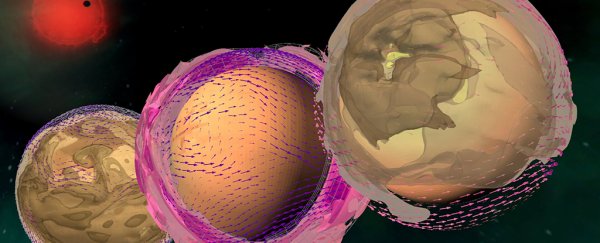With thousands of planets already discovered beyond our Solar System, astronomers are keen to figure out which ones might be habitable for extraterrestrial life. A new study has proposed an interesting method for doing this - by calculating the mineral dust on exoplanets.
This airborne dust - made of carbon-silicate material lifted from the planet's surface - isn't usually considered when modelling the climates of exoplanets, but researchers say it can actually have a significant effect on whether a planet is capable of supporting life.
Think of the 1984 sci-fi movie Dune, and you're not far off – high volumes of dust can potentially keep planets warmer or cooler depending on their composition and atmosphere. In turn, this would affect whether the planet still lands in the habitable zone that stretches out from its host star, potentially expanding that all-important criterion to more planetary systems.
The models put together by the team simulate the effects of dust on tidally locked planets, where the same side of the planet is always facing its sun. The 'day' side is cooled by the dust, and the 'night' side is warmed by it.
"On Earth and Mars, dust storms have both cooling and warming effects on the surface, with the cooling effect typically winning out," says astrophysicist Ian Boutle, from the Met Office and the University of Exeter in the UK. "But these 'synchronised orbit' planets are very different."
"Here, the dark sides of these planets are in perpetual night, and the warming effect wins out, whereas on the dayside, the cooling effect wins out. The effect is to moderate the temperature extremes, thus making the planet more habitable."
The researchers also found that on exoplanets closer to the host star, dust could create a feedback loop that delayed the loss of water from the surface, water that would otherwise be evaporated by hotter temperatures.
At the other end of the habitable zone, farthest from the star, dust can have a warming effect, absorbing and emitting infrared radiation. Ultimately, the impact that dust has depends on a number of factors, including the balance of land and oceans on the planet, and the make-up of its atmosphere.
Future exoplanet modelling should take these factors into consideration, say the authors of the new study – as well as acknowledging that dust can hide some of the key biomarkers, such as water vapour and oxygen, that are typically used to assess a planet's ability to support life.
"Airborne dust is something that might keep planets habitable, but also obscures our ability to find signs of life on these planets," says environmental scientist Manoj Joshi, from the University of East Anglia in the UK. "These effects need to be considered in future research."
We know from here on Earth that dust can have a significant impact on climate change and the modelling we use to predict it; thus, considering it as a factor in the hunt for life outside Earth might mean more exoplanets are worth a closer look.
Of course, studying planets from such a long distance across space is an incredible challenge, but as our telescopes improve and our calculations get more accurate, we're better able to identify where life might be present.
The habitable zone is usually defined as somewhere where conditions aren't so hot that surface water completely evaporates, and aren't so cold that surface water freezes. In addition, rocky planets are thought to have the best chance of harbouring life. Now it seems we've got another factor to add to our calculations.
"Research such as this is only possible by crossing disciplines, and combining the excellent understanding and techniques developed to study our own planet's climate with cutting-edge astrophysics," says astrophysicist Nathan Mayne, from the University of Exeter.
The research has been published in Nature Communications.
